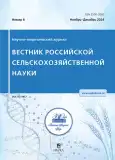Адаптивный потенциал продуктивности тритикале различного происхождения при выращивании в условиях Южного Дагестана
- Авторы: Гаджимагомедова М.Х.1, Куркиев К.У.1,2, Куркиев У.К.1
-
Учреждения:
- Дагестанская опытная станция – филиал Всероссийского института генетических ресурсов растений имени Н.И. Вавилова
- Дагестанский государственный университет
- Выпуск: № 6 (2024)
- Страницы: 20-22
- Раздел: Растениеводство и селекция
- URL: https://vestnik.nvsu.ru/2500-2082/article/view/659218
- DOI: https://doi.org/10.31857/S2500208224060052
- EDN: https://elibrary.ru/WUYMAT
- ID: 659218
Цитировать
Полный текст
Аннотация
В статье представлены результаты исследования урожайности и элементов структуры продуктивности у 32 сортообразцов гексаплоидной тритикале различного происхождения из мировой коллекции ВИР и сортов пшеницы (Ника Кубани, Таня). Работу проводили на Дагестанской ОС – филиал ВИР, расположенной в южной плоскостной зоне Республики Дагестан. Установлено, что при выращивании в низменной зоне Южного Дагестана сортообразцы тритикале превышали сорта пшеницы по признакам: урожайность, длина колоса, число колосков, зерен, масса зерна с колоса и 1000 зерен. Однако по некоторым показателям, определяющим потенциальную урожайность (число продуктивных стеблей и неозерненных цветков в колосе) тритикале уступает пшенице. По комплексу хозяйственно ценных признаков выделены образцы тритикале: ПРАГи – 494, 415/3, 479, 468, 483/1, 470/1 и 473/2, (Республика Дагестан), Престо 401 (Польша), Newton (Франция), TSW 2507 (Германия), которые можно рекомендовать в качестве исходного материала в практической селекционной работе при создании новых сортов с высокой продуктивностью.
Ключевые слова
Полный текст
Об авторах
Мина Ханмирзаевна Гаджимагомедова
Дагестанская опытная станция – филиал Всероссийского института генетических ресурсов растений имени Н.И. Вавилова
Email: kkish@mail.ru
ORCID iD: 0009-0000-7218-3473
младший научный сотрудник
Россия, ВавиловоКиштили Уллубиевич Куркиев
Дагестанская опытная станция – филиал Всероссийского института генетических ресурсов растений имени Н.И. Вавилова; Дагестанский государственный университет
Автор, ответственный за переписку.
Email: kkish@mail.ru
ORCID iD: 0000-0001-8232-6183
доктор биологических наук
Россия, Вавилово; МахачкалаУллубий Киштилиевич Куркиев
Дагестанская опытная станция – филиал Всероссийского института генетических ресурсов растений имени Н.И. Вавилова
Email: kkish@mail.ru
кандидат сельскохозяйственных наук
Россия, ВавиловоСписок литературы
- Гаджимагомедова М.Х., Куркиев К.У. Анализ продуктивности сортообразцов тритикале и исходных видов пшеницы и ржи // Научная жизнь. 2021. Т. 16. № 7(119). С. 839–847.
- Дорофеев В.Ф. Пшеницы мира. Л.: Агропромиздат, 1987. 560 с.
- Доспехов Б.А. Методика полевого опыта (с основами статистической обработки результатов исследований). М.: Агропромиздат, 1985.
- Куркиев У.К. Актуальные проблемы селекции тритикале и создание нового исходного материала// Труды по прикл. бот., ген. и сел. С.-Пб.: ВИР. 2011. Т. 158. С. 44–58.
- Куркиев У.К. Тритикале и проблемы его селекций. Методические указания. Л.: 1975. 18 с.
- Куркиев К.У., Муслимов М.Г., Мирзабекова М.С. и др. Влияние различных условий выращивания на проявление морфологических признаков колоса у гексаплоидной тритикале // Юг России: экология, развитие. 2016. Т. 11. № 2. С. 160–169.
- Методические указания. Пополнение, сохранение в живом виде и изучение мировой коллекции пшеницы, эгилопса и тритикале. С.-Пб, ВИР, 1999. 82 с.
- Рожь // Культурная флора СССР. Т. II. Ч.1. Под ред. В.Д. Кобылянского. Л.: 1989. 368 с.
- Kurkiev K.U., Adonina I.G., Gadjimagomedova M.Kh. et al. Biological and economic characteristics of the allotetraploid with genomic formula DDAUAUfrom the cereal family // Vavilov Journal of Genetics and Breeding. 2019. Т. 23. № 6. Р. 116–122.
- Muslimov M.G., Taimazova N.S., Arnautova G.I. et al. Comparative characteristics of productivity elements among film and huskless forms of oat // International Journal of Ecology and Development. 2017. Т. 32. № 4. С. 130–137.
Дополнительные файлы











